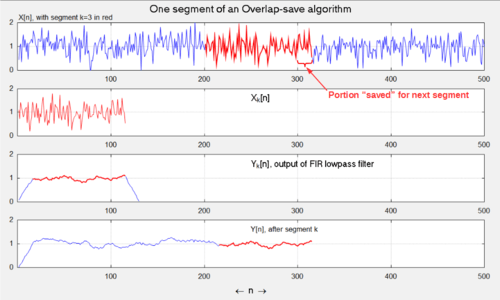Overlap–save method
Overlap–save is the traditional name for an efficient way to evaluate the discrete convolution between a very long signal and a finite impulse response (FIR) filter :
-
(Eq.1)
where h[m]=0 for m outside the region [1, M].

The concept is to compute short segments of y[n] of an arbitrary length L, and concatenate the segments together. Consider a segment that begins at n = kL + M, for any integer k, and define:
Then, for kL + M ≤ n ≤ kL + L + M − 1, and equivalently M ≤ n − kL ≤ L + M − 1, we can write:
The task is thereby reduced to computing yk[n], for M ≤ n ≤ L + M − 1. The process described above is illustrated in the accompanying figure.
Now note that if we periodically extend xk[n] with period N ≥ L + M − 1, according to:
the convolutions and are equivalent in the region M ≤ n ≤ L + M − 1. So it is sufficient to compute the N-point circular (or cyclic) convolution of with in the region [1, N]. The subregion [M, L + M − 1] is appended to the output stream, and the other values are discarded.
The advantage is that the circular convolution can be computed very efficiently as follows, according to the circular convolution theorem:
where:
- DFT and DFT−1 refer to the Discrete Fourier transform and inverse Discrete Fourier transform, respectively, evaluated over N discrete points, and
- N is customarily chosen to be an integer power-of-2, which optimizes the efficiency of the FFT algorithm.
- Optimal N is in the range [4M, 8M].
- Unlike the third graph in the figure above, depicting separate leading and trailing edge-effects, this method causes them to be overlapped and added. So they are discarded together. In other words, with circular convolution, the first output value is a weighted average of the last M-1 samples of the input segment (and the first sample of the segment). The next M-2 outputs are weighted averages of both the beginning and the end of the segment. The Mth output value is the first one that combines only samples from the beginning of the segment.
Pseudocode
(Overlap–save algorithm for linear convolution)
h = FIR_impulse_response
M = length(h)
overlap = M-1
N = 4*overlap (or a nearby power-of-2)
step_size = N-overlap
H = DFT(h, N)
position = 0
while position+N <= length(x)
yt = IDFT( DFT( x(1+position : N+position), N ) * H, N )
y(1+position : step_size+position) = yt(M : N) #discard M-1 y-values
position = position + step_size
end
Efficiency
When the DFT and its inverse is implemented by the FFT algorithm, the pseudocode above requires about N log2(N) + N complex multiplications for the FFT, product of arrays, and IFFT.[note 1] Each iteration produces N-M+1 output samples, so the number of complex multiplications per output sample is about:
-
(Eq.2)
For example, when M=201 and N=1024, Eq.2 equals 13.67, whereas direct evaluation of Eq.1 would require up to 201 complex multiplications per output sample, the worst case being when both x and h are complex-valued. Also note that for any given M, Eq.2 has a minimum with respect to N. It diverges for both small and large block sizes.
Overlap–discard
Overlap–discard[1] and Overlap–scrap[2] are less commonly used labels for the same method described here. However, these labels are actually better (than overlap–save) to distinguish from overlap–add, because both methods "save", but only one discards. "Save" merely refers to the fact that M − 1 input (or output) samples from segment k are needed to process segment k + 1.
Extending overlap–save
The overlap-save algorithm may be extended to include other common operations of a system:[note 2][3]
- additional channels can be processed more cheaply than the first by reusing the forward FFT
- sampling rates can be changed by using different sized forward and inverse FFTs
- frequency translation (mixing) can be accomplished by rearranging frequency bins
See also
Notes
- ↑ Cooley-Tukey FFT algorithm for N=2k needs (N/2) log2(N) - see FFT - Definition and speed
- ↑ Carlin et al. 1999, p 31, col 20.
References
- ↑ Harris, F.J. (1987). "Time domain signal processing with the DFT". Handbook of Digital Signal Processing, D.F.Elliot, ed., San Diego: Academic Press. pp 633–699. ISBN 0122370759.
- ↑ Frerking, Marvin (1994). Digital Signal Processing in Communication Systems. New York: Van Nostrand Reinhold. ISBN 0442016166.
- ↑ Borgerding, Mark (2006), "Turning Overlap-Save into a Multiband Mixing, Downsampling Filter Bank" (PDF), IEEE Signal Processing Magazine (March 2006): 158–161
- US patent 6898235, Carlin, Joe; Terry Collins & Peter Hays et al., "Wideband communication intercept and direction finding device using hyperchannelization", published 1999, issued 2005
Further reading
- Rabiner, Lawrence R.; Gold, Bernard (1975). Theory and application of digital signal processing. Englewood Cliffs, N.J.: Prentice-Hall. pp 65–67. ISBN 0139141014.